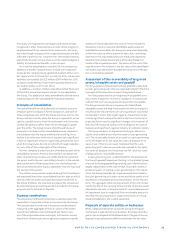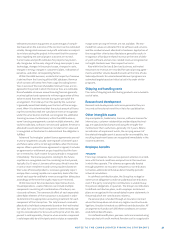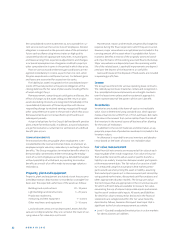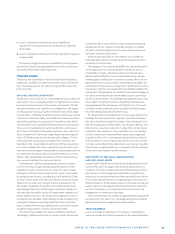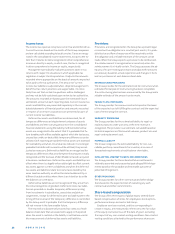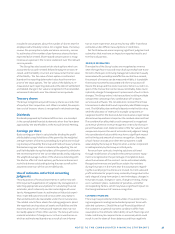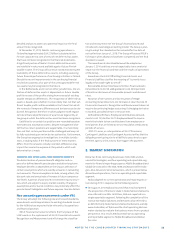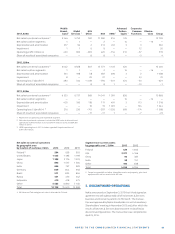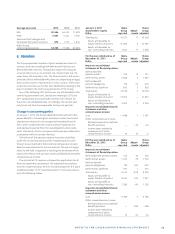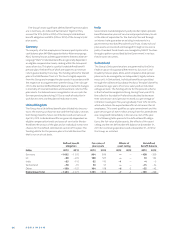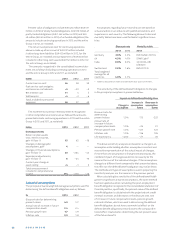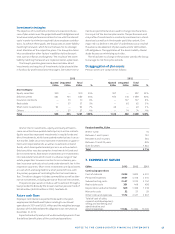Nokia 2013 Annual Report Download - page 41
Download and view the complete annual report
Please find page 41 of the 2013 Nokia annual report below. You can navigate through the pages in the report by either clicking on the pages listed below, or by using the keyword search tool below to find specific information within the annual report.39
NOTES TO THE CONSOLIDATED FINANCIAL STATEMENTS
detailed analysis to assess any potential impact on the fi nal
amount to be recognized.
At December , , Nokia’s continuing operations in
Finland had approximately EUR . billion (calculated at the
Finnish corporate tax rate of %) of net deferred tax assets
that have not been recognized in the fi nancial statements.
Asignifi cant portion of Nokia’s Finnish deferred tax assets
are indefi nite in nature and available against future Finnish
taxable income. The Group will continue closely monitoring the
realizability of these deferred tax assets, including assessing
future fi nancial performance of continuing activities in Finland.
Should the recent improvements in the continuing fi nancial
results be sustained, all or part of the unrecognized deferred
tax assets may be recognized in the future.
In the Netherlands and in certain other jurisdictions, the uti-
lization of deferred tax assets is dependent on future taxable
profi t in excess of the profi ts arising from reversal of existing
taxable temporary diff erences. The recognition of deferred tax
assets is based upon whether it is more likely than not that suf-
fi cient taxable profi ts will be available in the future from which
the reversal of temporary diff erences and tax losses can be de-
ducted. Recognition therefore involves judgment with regard
to future fi nancial performance of a particular legal entity or
tax group in which the deferred tax asset has been recognized.
Liabilities for uncertain tax positions are recorded based on
estimates and assumptions when, despite management’s be-
lief that tax return positions are supportable, it is more likely
than not that certain positions will be challenged and may not
be fully sustained upon review by tax authorities. Furthermore,
the Group has ongoing tax investigations in multiple jurisdic-
tions, including India. If the fi nal outcome of these matters
diff ers from the amounts initially recorded, diff erences may
impact the income tax expense in the period in which such
determination is made.
PENSIONS AND OTHER LONG-TERM EMPLOYEE BENEFITS
The determination of pension benefi t obligation and ex-
pense for defi ned benefi t pension plans and other long-term
employee benefi ts is dependent on the Group’s selection of
certain assumptions which are used by actuaries in calculating
such amounts. Those assumptions include, among others, the
discount rate and annual rate of increase in future compensa-
tion levels. A portion of plan assets is invested in equity securi-
ties, which are subject to equity market volatility. Changes in
assumptions and actuarial conditions may materially aff ect the
pension benefi t obligation and future expense. See also Note .
New accounting pronouncements under IFRS
The Group will adopt the following new and revised standards,
amendments and interpretations to existing standards issued
by the IASB that are expected to be relevant to its operations
and fi nancial position:
IFRS Financial Instruments refl ects the fi rst phase of the
IASB’s work on the replacement of IAS Financial Instruments:
Recognition and Measurement and will change the classifi ca-
tion and measurement of the Group’s fi nancial assets and
introduced a new hedge accounting model. The Group is plan-
ning to adopt the standard on the revised eff ective date of
not earlier than January , . The Group will assess IFRS ’s
full impact when all phases have been completed and the fi nal
standard is issued.
The amendments described below will be adopted on
January , and they are not expected to have a material
impact on the fi nancial condition and the results of operations
of the Group.
Amendment to IAS Off setting Financial Assets and
Financial Liabilities clarifi es the meaning of “currently has a
legally enforceable right to set-off ”.
Recoverable Amount Disclosures for Non-Financial Assets
(Amendments to IAS ) adds guidance to IAS Impairment
of Assets on disclosure of recoverable amounts and discount
rates.
Novation of Derivatives and Continuation of Hedge
Accounting (Amendments to IAS ) makes it clear that IAS
Financial Instruments: Recognition and Measurement does not
require discontinuing hedge accounting if a hedging derivative
is novated, provided certain criteria are met.
Defi ned Benefi t Plans: Employee Contributions (Amend-
ments to IAS ) clarifi es IAS Employee Benefi ts require-
ments that relate to how contributions from employees or
third parties that are linked to service should be attributed to
periods of service.
IFRIC Levies, an interpretation of IAS Provisions,
Contingent Liabilities and Contingent Assets clarifi es that the
obligating event giving rise to a liability to pay a levy to a gov-
ernment agency is the activity that triggers the payment.
2. SEGMENT INFORMATION
Nokia has three continuing businesses: NSN, HERE and Ad-
vanced Technologies, and four operating and reportable seg-
ments for fi nancial reporting purposes: Mobile Broadband and
Global Services within the NSN, HERE and Advanced Technolo-
gies. Also, Devices & Services business, which is presented as
discontinued operations, forms an operating and reportable
segment.
Nokia adopted its current operational and reporting struc-
ture during in response to the following events:
■ On August , Nokia announced that it had completed
the acquisition of Siemens’ stake in Nokia Siemens Networks
also referred to as NSN. Until then, NSN was reported as a
single reportable segment. Following the completion of the
transaction Nokia Solutions and Networks also referred to
as NSN (formerly Nokia Siemens Networks) became a wholly
owned subsidiary of Nokia and the chief operating decision
maker started to evaluate the business more from a product
perspective. As a result, NSN business has two operating
and reportable segments, Mobile Broadband and Global
Services.


